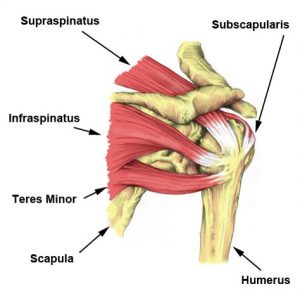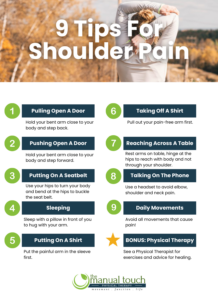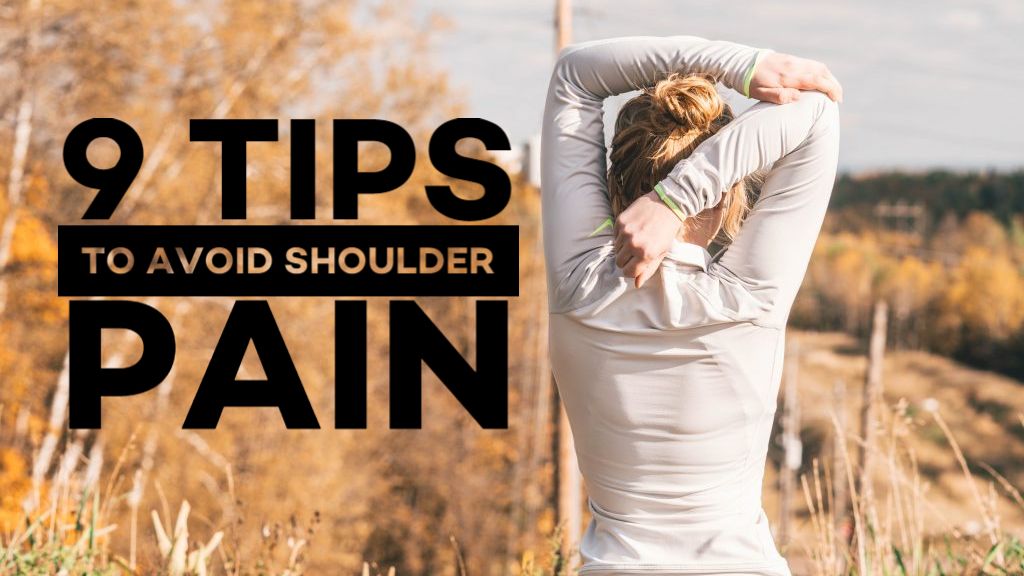Click here to download our PDF guide: 9 Tips for Shoulder Pain.
Betty had constant shoulder pain. Her shoulder hurt doing just about anything — opening doors, sleeping, putting on her seatbelt, and even while sitting in a movie theater. As Betty is 81 years old, she and her doctor did not want her to have surgery for her torn rotator cuff.
Betty came to therapy regularly for about four months. She received exercises and instructions on how to go about her life without aggravating her shoulder. At times during her therapy, we both thought she might need to have surgery. Thankfully, after 8 weeks of therapy she began to get progressively better until she became pain-free and was able to enjoy her life again. When I spoke to Betty a year after she left physical therapy, she was still doing great. Read Betty’s testimonial here.
After having shoulder pain for a year, Jodi, a 53 year old pediatric physical therapist, realized she could not get rid of her shoulder pain on her own. Sometimes even health professionals need an objective eye from another health professional to figure out what’s going on.
Being a pediatric physical therapist is a physically demanding job that can take its toll on your body. We assessed how Jodi used her body when working with kids and we found that Jodi was so good at stabilizing her core, keeping her body very rigid, that she was overusing her arms to assist her patients. I instructed her how to use her great core stability to her advantage in order to not overuse her arms. In addition, she was given exercises to integrate her body with her shoulder as well as manual therapy. Jodi is now back at work, doing yoga and weight lifting pain-free. Read Jodi’s testimonial here.
Shoulder pain can be quite debilitating as we use our arms all the time.

The primary shoulder joint is a connection between the shoulder blade (scapula) and arm bone (humerus) and can move in multiple directions, making it prone to injury as well as wear and tear.
The primary muscles that control shoulder movement is the rotator cuff, a group of 4 muscles that can easily be strained or torn. The upper back and core muscles act to stabilize your body so you can move your arm safely from a stable position.
Other common shoulder pain issues include:
- Rotator cuff tear
- Labrum tear
- Dislocation or subluxing joint
- Arthritis, degeneration, or spur
- Frozen shoulder
- Bursitis
- Fracture of any of the bones
Things you can do to alleviate and avoid shoulder pain
Here are nine easy tips that will help you protect your shoulder from injury and prevent pain if you already have a shoulder issue.
1. Pulling open a door – Hold your bent arm close to your body and step back instead of pulling with your arm
2. Pushing a door open – Hold your bent arms close to body, push door open stepping forward in order to use your body
3. Putting on a seatbelt – Hold your arms close to body, turn your body at your hips to reach for seatbelt, turn your body at your hips to the other direction, which will pull belt down towards buckle, push buckle in by bending at your hips to use your body to apply force through your arms.
4. Sleeping – Lay on whichever side doesn’t increase your pain, sleep with a pillow in front of you to hug with your arm.
5. Putting on a shirt or coat – Put the painful arm in the sleeve first.
6. Taking off a shirt or coat – Pull out pain-free arm first.
7. Reaching across a table – Rest arms on table, hinge at hips to reach with body and not through your shoulder.
8. Talking on the phone – Use a headset to avoid elbow, shoulder and neck pain.
9. Throughout your day – Avoid all movements that cause pain!
 Click here to download our PDF guide: 9 Tips for Shoulder Pain.
Click here to download our PDF guide: 9 Tips for Shoulder Pain.
Want to take care of that shoulder pain so you can get back to doing the things you love to do? Give us a call at 847-541-7600 or email: info@themanualtouch.com.







Leave a Reply